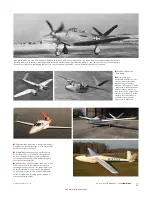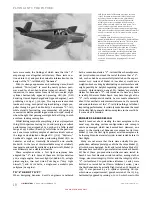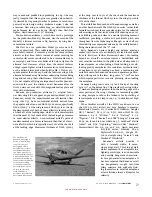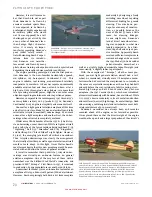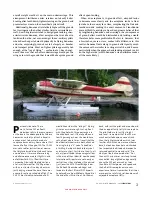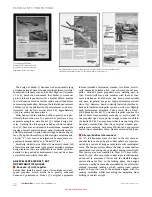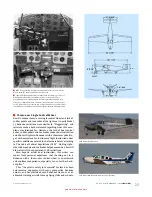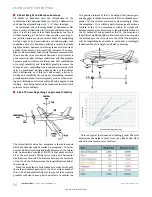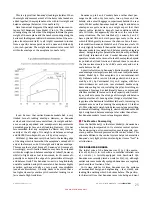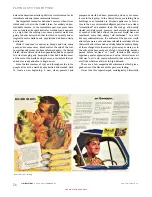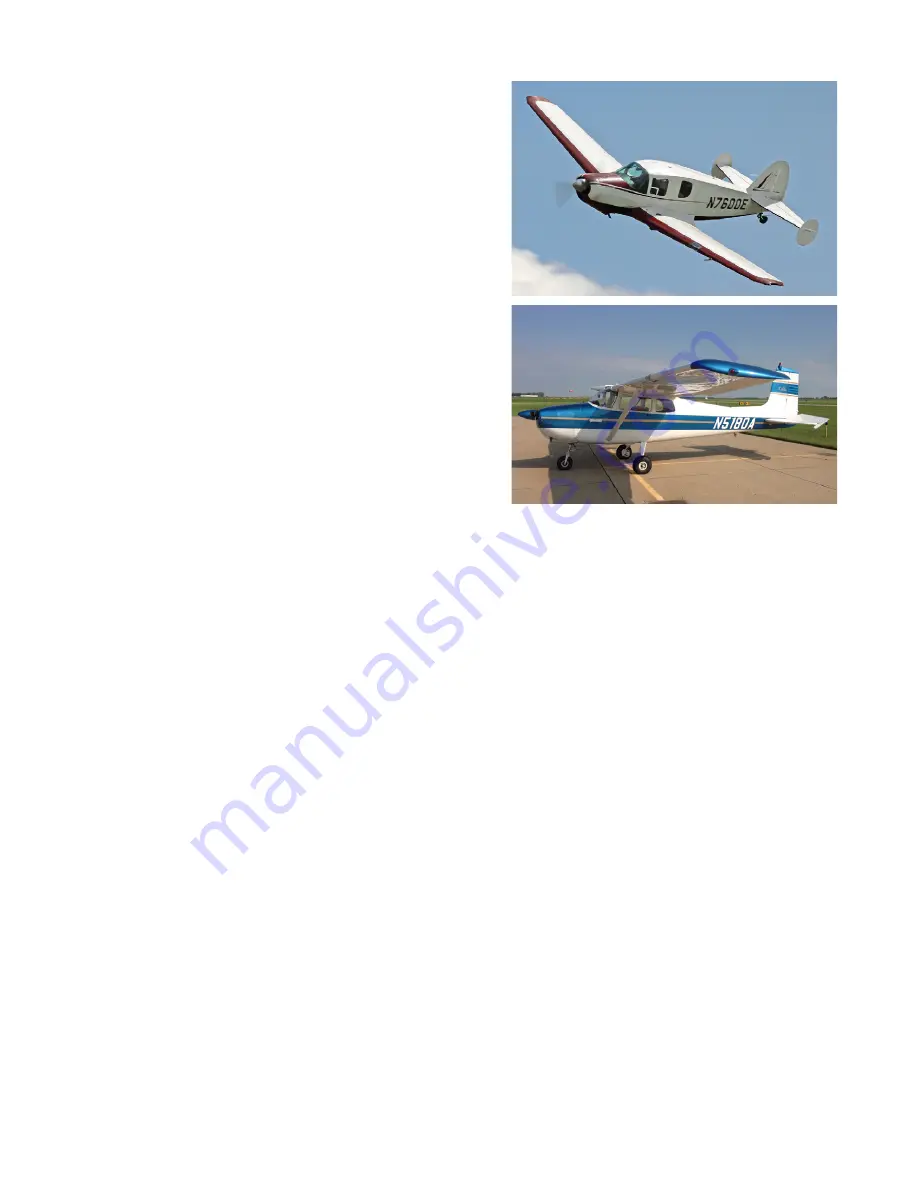
www.a2asimulations.com
ACCU-SIM V35B BONANZA
:::
A2A
SIMULATIONS
11
FOR SIMULATION USE ONLY
■
1949 Bellanca 14- 19 “Cruisemaster.” An upgrade of the pre- war
Bellanca 14- 7 and the post- war Bellanca 14- 13, 14- 19 has a large,
comfortable cabin for four and is powered by a Franklin 6A4- 335- B3
190 hp engine. “Cruisemaster’s” triple tail and its wooden wing
garnered it the nickname “Cardboard Constellation” after Lockheed’s
“Constellation.” However, like Lockheed’s triple- tail marvel,
“Cruisemaster’s” performance was in many ways better than its similar
contemporaries, including Bonanza, with a useful load of 1,025 lbs,
a top airspeed of 174 mph, a rate of climb of 1,250 fpm and a fully-
loaded range of 435 miles. A tailwheel aeroplane with retractable main
undercarriage in the new tricycle undercarriage world, its retro wood
and fabric construction and undeniably quirky appearance did not aid
its overall public acceptance. Whilst in 1959 14- 19 would be converted
to a retractable tricycle undercarriage by “Downer Aircraft” (Bellanca’s
new name,) only around 600 of the original 14- 19 “Cruisemasters” were
produced. Whilst in many ways “Cruisemaster” is a better- performing
aeroplane, Bonanza remained unchallenged.
■
Cessna 172. Introduced in 1956, it was the direct competitor of Piper
Tri- Pacer. All metal and looking far more modern than Tri- Pacer, C- 172
is a Cessna 170 with a nose wheel. Despite its sleek appearance, C- 172
does not perform as well as Tri- Pacer in many areas. 160 hp versions
of C- 172 give it a useful load of only 758 lbs, a top airspeed of 140 mph,
a rate of climb of 721 fpm and a possible range of 696 miles, but with
only two rather slim passengers on board. Cessna 172 might have well-
competed with Tri- Pacer but it, too, was no competition for Bonanza.
known as the “G. I. Bill,” designed and largely drafted by
the American Legion and the Veterans of Foreign Wars, was
a Federal entitlement program which provided a range of
financial benefits, including free flight instruction all the
way to an Airline Transport Rating, for returning WWII vet-
erans. Aircraft manufacturers were all quite aware of this
and they saw it as a boost to what they believed would be a
glorious new, commercially lucrative general aviation boom.
The aeroplanes that they had been producing before being
interrupted by the war - Piper J- 3 “Cubs”, Taylorcrafts.
Stinsons and the like would be just perfect, or so they
thought. What was not spoken of if it was thought of at all
was that immediately after the end of the war a tremendous
glut of surplus “grasshoppers” (all of those high- wing, low
powered, mostly two- seat aircraft) would be offered as sur-
plus to the public at very low prices. For instance, in 1945
the Office of Price Administration (OPA) made surplus two-
seat Aeronca L- 3B “Champs” in virtually unused condition
available for $1,788.00 ($19,963.94 in 2018 at a cumulative
rate of inflation of 1,016.6%) and four- seat Stinson UC- 81/
AT- 19 “Reliants” available for $6,736.00 ($75,210.91 in
2018 at the same rate of inflation.)
However, Walter Beech and his staff had a completely
different view of what Beech’s role would ideally be in the
post- war future. Their experience with light aircraft had
solely been with Model 17 “Staggerwing”, a fairly large and
expensive executive aeroplane. Beech’s plan was that its
new post- war aeroplane would well- fit this role.
In 1945 and for a decade and a half thereafter, the now-
familiar culture of the casual weekend pilot who usually flies
locally in good weather with friends and family to sight-
see and perchance to purchase a few of those $100 dollar
hamburgers at a far- off little airport’s snack bar, the vast
majority of whom have little flight time and are not instru-
ment (IFR) rated, did not yet exist. Accordingly, once plans
for what became Bonanza began to develop, an important
aspect of this aeroplane’s design was that it did not include
compromises which would make it especially forgiving or
gentle- flying, particularly not at the expense of perfor-
mance. Thus, Bonanza was not intended to cater to the
aforementioned not- yet- existent culture of casual pilots.
Rather, it was designed to be a business tool, an executive
transport aeroplane which would be owned by success-
ful businesses and flown by professional pilots who would
transport those executives who required quick, private and
convenient transportation to places that were too distant or
inconvenient for efficient ground travel. Oh yes, and lest we
forget, Bonanza was also intended to be an exclusive, con-
spicuous totem of financial accomplishment.
Since its introduction in 1936, and into the early 1940s,
Walter Beech and Co. had been well and painfully aware of
their greatest competitor in the corporate aviation genre:
Spartan Aircraft Company’s 7W “Executive.” This highly
advanced aeroplane is a sleek and muscular- looking, all-
metal, retractable undercarriage, low-
wing monoplane
which exhibited spectacular performance for its time, with
a top airspeed of 257 mph (223 knots, 414 km/h) whilst
Summary of Contents for BONANZA ACCU-SIM V35B
Page 1: ...A2ASIMULATIONS BONANZA ACCU SIM V35B BONANZA ...
Page 3: ...A2ASIMULATIONS BONANZA ACCU SIM V35B BONANZA ...
Page 5: ...www a2asimulations com ACCU SIM V35B BONANZA A2ASIMULATIONS 5 FOR SIMULATION USE ONLY ...
Page 27: ...www a2asimulations com ACCU SIM V35B BONANZA A2ASIMULATIONS 27 FOR SIMULATION USE ONLY ...
Page 58: ......
Page 68: ...68 A2ASIMULATIONS ACCU SIM V35B BONANZA www a2asimulations com FOR SIMULATION USE ONLY ...
Page 112: ......

















